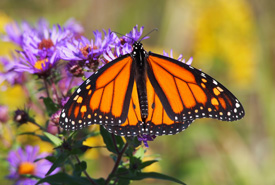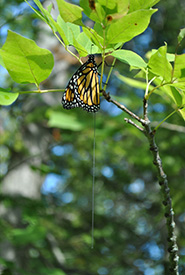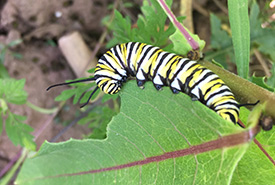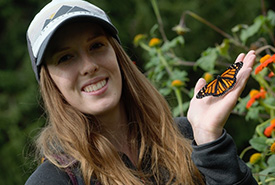Monarch migration

Monarch (Photo by NCC)
Fall is fast approaching. As the days grow shorter and temperatures drop, it’s time for monarchs to migrate south for the winter. These iconic bright-orange butterflies will soon be replaced by pumpkins and turning leaves.
Monarchs spend the summer searching for milkweeds, the only group of plants they can lay their eggs on. Caterpillars hatched from these eggs feed and grow on this milkweed, their sole food source until they feed on nectar as adult butterflies. As fall approaches, monarchs no longer search for milkweeds; this generation of long-lived monarchs is preparing for a journey of thousands of kilometres. These migrating monarchs will live for approximately six to nine months; much longer than the summer adults that live for only two to six weeks.
Related blog posts
Tracking monarchs during migration

A monarch equipped with a radio transmitter. Only the antenna is visible below. (Photo by Rachael Derbyshire)
There are two populations of monarchs in Canada. Monarchs in the east migrate to the Sierra Madre Mountains of central Mexico, while monarchs west of the Rocky Mountains migrate to California.
The Nature Conservancy of Canada’s (NCC’s) Grace Pitman (assistant, conservation biology), Ryan Norris (Weston Family senior scientist) and myself recently published a scientific article about our research tracking eastern monarchs during fall migration. With the appropriate permits, Grace caught monarchs at the northern tip of the Bruce Peninsula in Ontario, and equipped them with tiny radio transmitters. These devices broadcasted a radio signal that was picked up by towers from the Motus Wildlife Tracking System as individuals flew by during migration.
Using this technology, monarchs were tracked south through Ontario. One individual was even detected in Indiana! The batteries on these devices died before we could track them any farther, but it was very exciting to see how they moved through Ontario during migration.
We found that they could travel over 100 kilometres in a single day! They also took advantage of favourable winds and warm temperatures to migrate faster. The top speed we estimated for these migrating monarchs was 31 kilometres per hour, thanks to the assistance of tailwinds. This research has given us a glimpse into their magnificent migration.
Monarch conservation
This study is a part of a larger research program by the Norris lab at the University of Guelph, aimed at learning more about the endangered monarch. Unfortunately, monarch populations have declined dramatically by over 80 per cent in the past few decades. Some threats they face include loss of milkweed on their breeding grounds, overwintering habitat loss and climate change. Our lab has studied migration patterns, threats to monarchs and management actions that can best help reverse their decline.

Monarch caterpillar (Photo by NCC)
You can help too!
Planting native milkweeds and other native flowering plants in your garden or community is a great way to support monarch conservation. For example, if you live in eastern Canada, plant common milkweed. Fall is the time to spread milkweed seeds that will germinate next spring. By adding more milkweed to the landscape, we can give monarchs a greater opportunity to lay eggs.
To help fuel their physically demanding fall migration, add more native plants that flower in late summer and fall (such as goldenrod) to your garden. And when the monarchs return next spring, surprise them with all of the new plants in your garden. Hopefully they’ll pay you a visit, and maybe you’ll get to see some eggs or caterpillars on the milkweed!
For now, enjoy seeing the last of the monarchs of the season as they fuel up and start their magnificent migration.


